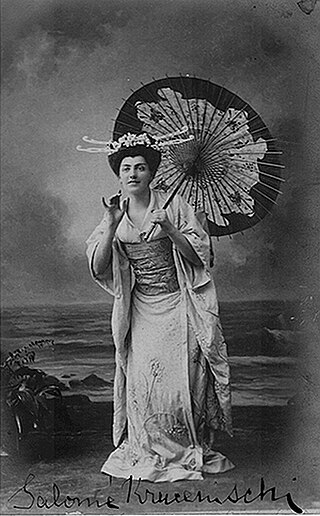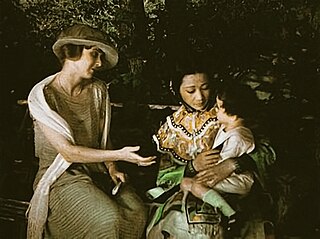Loading AI tools
1904 opera by Giacomo Puccini From Wikipedia, the free encyclopedia
Madama Butterfly (Italian pronunciation: [maˈdaːma ˈbatterflai]; Madame Butterfly) is an opera in three acts (originally two) by Giacomo Puccini, with an Italian libretto by Luigi Illica and Giuseppe Giacosa.
| Madama Butterfly | |
|---|---|
| Opera by Giacomo Puccini | |
 Original 1904 poster by Adolfo Hohenstein | |
| Librettist | |
| Language | Italian |
| Based on | |
| Premiere | |
It is based on the short story "Madame Butterfly" (1898) by John Luther Long, which in turn was based on stories told to Long by his sister Jennie Correll and on the semi-autobiographical 1887 French novel Madame Chrysanthème by Pierre Loti.[1][2][3] Long's version was dramatized by David Belasco as the one-act play Madame Butterfly: A Tragedy of Japan, which, after premiering in New York in 1900, moved to London, where Puccini saw it in the summer of that year.[4]
The original version of the opera, in two acts, had its premiere on 17 February 1904 at La Scala in Milan. It was poorly received, despite having such notable singers as soprano Rosina Storchio, tenor Giovanni Zenatello and baritone Giuseppe De Luca in lead roles. This was due in part to a late completion by Puccini, which gave inadequate time for rehearsals. Puccini revised the opera, splitting the second act in two, with the Humming Chorus as a bridge to what became Act III, and making other changes. Success ensued, starting with the first performance on 28 May 1904 in Brescia.[5]

Puccini wrote five versions of the opera. The original two-act version,[6] which was presented at the world premiere at La Scala on 17 February 1904, was withdrawn after the disastrous premiere. Puccini then substantially rewrote it, this time in three acts. This second version[7] was performed on 28 May 1904 in Brescia, where it was a great success, with Solomiya Krushelnytska as Cio-Cio-san. It was this second version that premiered in the United States in 1906, first in Washington, D.C., in October, and then in New York in November, performed by Henry Savage's New English Opera Company (so named because it performed in English-language translations).[citation needed]
In 1906, Puccini wrote a third version,[8] which was performed at the Metropolitan Opera in New York on 11 February 1907. Later that year, Puccini made several changes in the orchestral and vocal scores, and this became the fourth version.[9]
Again in 1907, Puccini made his final revisions to the opera in a fifth version,[10][11] which has become known as the "Standard Version" and is the one which is most often performed today. However, the original 1904 version is occasionally performed, such as for the opening of La Scala's 2016–17 season, on 7 December 2016, with Riccardo Chailly conducting.[12]
Premieres of versions of Madama Butterfly in major opera houses throughout the world include the Teatro de la Opera de Buenos Aires on 2 July 1904, under Arturo Toscanini, this being the first performance in the world outside Italy. Its first performance in Britain was in London on 10 July 1905 at the Royal Opera House, Covent Garden, while the first US performance was presented in English on 15 October 1906, in Washington, D.C., at the Columbia Theater. The first performance in New York took place on 12 November of the same year at the Garden Theatre.[13] The Metropolitan Opera first performed the opera on 11 February 1907 under the supervision of the composer with Geraldine Farrar as Cio-Cio-San, Enrico Caruso as Pinkerton, Louise Homer as Suzuki, Antonio Scotti as Sharpless, with Arturo Vigna conducting;[14] Madama Butterfly has since been heard virtually every season at the Met except for a hiatus during World War II from 1942 through 1945 due to the hostilities between the United States and Japan. The first Australian performance was presented at the Theatre Royal in Sydney on 26 March 1910, starring Amy Eliza Castles.[15]
Between 1915 and 1920, Japan's best-known opera singer Tamaki Miura won international fame for her performances as Cio-Cio-San. A memorial to this singer, along with one to Puccini, can be found in the Glover Garden in the port city of Nagasaki, where the opera is set.[16]
| Role | Voice type | Premiere cast, 17 February 1904 Conductor: Cleofonte Campanini[17] |
Brescia cast, 28 May 1904 Conductor: Cleofonte Campanini[18] |
|---|---|---|---|
| Cio-Cio-San (Madama Butterfly) | soprano | Rosina Storchio | Solomiya Krushelnytska |
| Suzuki, her maid | mezzo | Giuseppina Giaconia | Giovanna Lucaszewska |
| B.F. Pinkerton, Lt. in the U.S. Navy[19]: 73–4 | tenor | Giovanni Zenatello | Giovanni Zenatello |
| Sharpless, U.S. consul at Nagasaki | baritone | Giuseppe De Luca | Virgilio Bellatti |
| Goro, a matchmaker | tenor | Gaetano Pini-Corsi | Gaetano Pini-Corsi |
| Prince Yamadori | baritone | Emilio Venturini | Fernando Gianoli Galletti |
| The Bonze, Cio-Cio-san's uncle | bass | Paolo Wulman | Giuseppe Tisci-Rubini |
| Yakusidé, Cio-Cio-san's uncle | bass | Antonio Volponi | Fernando Gianoli Galletti |
| The Imperial Commissioner | bass | Aurelio Viale | Luigi Bolpagni |
| The Official Registrar | bass | Ettore Gennari | Anselmo Ferrari |
| Cio-Cio-san's mother | mezzo | Tina Alasia | Serena Pattini |
| The aunt | soprano | ? | Adele Bergamasco |
| The cousin | soprano | Palmira Maggi | Carla Grementieri |
| Kate Pinkerton | mezzo | Margherita Manfredi | Emma Decima |
| Dolore ("Trouble"), Cio-Cio-san's son | silent | Ersilia Ghissoni | Ersilia Ghissoni |
| Cio-Cio-san's relatives and friends and servants | |||

In 1904, a U.S. naval officer named Pinkerton rents a house on a hill in Nagasaki, Japan, for himself and his soon-to-be wife, "Butterfly". Her real name is Cio-Cio-San (from the Japanese word for "butterfly" (蝶々, chōchō, pronounced [tɕoꜜːtɕoː]); -san is a plain honorific). She is a 15-year-old Japanese girl whom he is marrying for convenience, and he intends to leave her once he finds a proper American wife, since Japanese divorce laws are very lenient. The wedding is to take place at the house. Butterfly had been so excited to marry an American that she had earlier secretly converted to Christianity. After the wedding ceremony, her uninvited uncle, a bonze, who has found out about her conversion, comes to the house, curses her and orders all the guests to leave, which they do while renouncing her. Pinkerton and Butterfly sing a love duet and prepare to spend their first night together.

Pinkerton left shortly after the wedding, and three years later, Butterfly is still waiting for him to return. Her maid Suzuki keeps trying to convince her that he is not coming back, but Butterfly does not believe her. Goro, the marriage broker who arranged her marriage, keeps trying to marry her off again, but she does not listen to him either. The American consul, Sharpless, comes to the house with a letter which he has received from Pinkerton which asks him to break some news to Butterfly: that Pinkerton is coming back to Japan, but Sharpless cannot bring himself to finish it because Butterfly becomes very excited to hear that Pinkerton is coming back. Sharpless asks Butterfly what she would do if Pinkerton were not to return. She then reveals that she gave birth to Pinkerton's son after he had left and asks Sharpless to tell him.
From the hill house, Butterfly sees Pinkerton's ship arriving in the harbour. She and Suzuki prepare for his arrival, and then they wait. Suzuki and the child fall asleep, but Butterfly stays up all night waiting for him to arrive.
Suzuki wakes up in the morning and Butterfly finally falls asleep. Sharpless and Pinkerton arrive at the house, along with Pinkerton's new American wife, Kate. They have come because Kate has agreed to raise the child. But, as Pinkerton sees how Butterfly has decorated the house for his return, he realizes he has made a huge mistake. He admits that he is a coward and cannot face her, leaving Suzuki, Sharpless, and Kate to break the news to Butterfly. Agreeing to give up her child if Pinkerton comes himself to see her, she then prays to statues of her ancestral gods, says goodbye to her son, and blindfolds him. She places a small American flag in his hands and goes behind a screen, stabbing herself with her father's seppuku knife. Pinkerton rushes in, but he is too late, and Butterfly dies.
Madama Butterfly is scored for three flutes (the third doubling piccolo); two oboes, English horn; two clarinets in B-flat; bass clarinet in B-flat, two bassoons; four French horns in F; three trumpets in F; three tenor trombones; bass trombone; a percussion section with timpani, cymbals, triangle, snare drum, bass drum, bells, tam-tam, Japanese gong, and 4 "Japanese Bells"; keyboard glockenspiel; onstage "little bell"; onstage tubular bells; onstage viola d'amore; onstage bird whistles; onstage tam-tam; onstage bass tam-tam; harp; and strings.[20]
The premiere in Milan was a fiasco, as Puccini's sister, Ramelde, wrote in a letter to her husband:[21]
At two o'clock we went to bed and I can't sleep one bit; and to say that we were all so sure! Giacomo, poor thing, we never saw him because we couldn't go on the stage. We got to the end of it and I don't know how. The second act I didn't hear at all, and before the opera was over, we ran out of the theater.
Called "one of the most terrible flops in Italian opera history", the premiere was beset by several bad staging decisions, including the lack of an intermission during the second act. Worst of all was the idea to give audience plants nightingale whistles to deepen the sense of sunrise in the final scene. The audience took the noise as a cue to make their own animal noises.[22]
Madama Butterfly has been criticized by some American intellectuals[23] for orientalism. Despite these opinions, Madama Butterfly has been successfully performed in Japan in various adaptions from 1914.[24]
Today Madama Butterfly is the sixth most performed opera in the world[25] and considered a masterpiece, with Puccini's orchestration praised as limpid, fluent and refined.[26][27]

Seamless Wikipedia browsing. On steroids.
Every time you click a link to Wikipedia, Wiktionary or Wikiquote in your browser's search results, it will show the modern Wikiwand interface.
Wikiwand extension is a five stars, simple, with minimum permission required to keep your browsing private, safe and transparent.